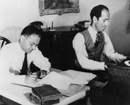People in the News
New Artist of the Month: Designer Wendy Waszut-Barrett
 For 15 years Chicago’s Haymarket Opera Company has been presenting enchanting productions of baroque opera. These are often rarely heard works like Telemann’s Pimpinone and feature top-notch singers and an orchestra entirely at home with baroque opera’s high-flying ruffles and flourishes.
For 15 years Chicago’s Haymarket Opera Company has been presenting enchanting productions of baroque opera. These are often rarely heard works like Telemann’s Pimpinone and feature top-notch singers and an orchestra entirely at home with baroque opera’s high-flying ruffles and flourishes.
But it’s Haymarket’s period-inspired scenic designs that fully transport listeners back to the baroque era. Against a hanging backdrop, painted flats slide in and out from the wings, encompassing the singers like an intricately colored pop-up greeting card. Since 2022 Wendy Waszut-Barrett, a Minneapolis-based scenic artist and scenic arts scholar, has created that visual magic for Haymarket.
The company’s focus may be baroque opera, but Waszut-Barrett’s materials and techniques have roots in a less rarefied realm. Her glowing, hand-painted sets echo a centuries-old painting system used by highly skilled American scenery painters in the late 1800s through the 1920s. Working for companies with names like The Great Western Stage Equipment Company (Kansas City, Mo,), they painted sets for clients ranging from local schools and theaters to Broadway touring companies, Ringling Bros. circuses and Masonic lodges. Before movies dominated the entertainment scene, live theater was ubiquitous in large cities and small towns throughout the U.S.
Waszut-Barrett first encountered the long-forgotten practice—the distemper painting system—during her undergraduate years at the University of Minnesota. Enrolling in 1987, she earned her bachelor, masters and doctoral degrees at the university’s campus in St. Paul.
“I went to college with the intent of going into directing, choreography and the performing end,” she said in a video interview. Lively and engaging, she is infectiously enthusiastic describing what has become her life’s work, both as a hands-on designer and a scholar. “I never thought about scenery at all.”
But she had always like drawing, and the university’s theater arts programs required courses she might not have taken otherwise. One of them was an introduction to technical theater history. It lit a spark she didn’t know was there. “That’s when I started to become involved in scenic art.”
 Gilbert and Sullivan Very Light Opera Company's production of The McAdo, 2024
Gilbert and Sullivan Very Light Opera Company's production of The McAdo, 2024
Her teacher, C. Lance Brockman, now a U of M emeritus professor, required students to learn the long-abandoned distemper paint system. The system mixes dry pigment—available in an infinite range of colors—with animal hide glue. Students learned how to handle it by copying work by 20th-century artist Edward Hopper.
As Brockman’s research assistant, Waszut-Barrett worked on a project cleaning and cataloging his historic scenery collection from The Great Western Stage Equipment Co. The immediate goal was to prepare the scenery for Brockman’s students to copy in the studio.
“As I’m thinking about a career in scenic arts, I’m also processing this collection,” she said. “I took these historic designs and duplicated them. I’d take a small section and enlarge it to study the painting techniques. This was all on my own time because I really was enjoying painting.”
Waszut-Barrett soon fell in love with the system’s versatility. There’s very little waste because artists can mix large or small batches of color as needed. They control the texture by adjusting the ratio of pigment to glue. Paint goes on in thin layers, and layering different colors creates a wash of glowing images. Backlighting the sets can create an entirely different, often other-worldly illusion.
Theory into practice
After decades of historical research and hands-on work, Waszut-Barret has taught herself the distemper system’s intricate color theory. “There’s a division of hue, a separation of color from one [layer] to the next,” she said. “Say I’m doing dark, cool leaves on a tree. I do a mixture of green.”
“I hardly ever use green for the green; I do a mixture of yellow and blue. So I have a cool version of dark green, a mid-tone version of dark green, a cool version of a highlight green and a warm version of a flesh color. And from that, the light reflects differently and reinforces painted illusion.”
Restoring historic theatrical scenery is the focus of Waszut-Barrett’s company, Historic Stage Services. She travels extensively, especially in the U.S., restoring dusty rolls of scenery found in the attics of long-closed 19th-century theaters or Masonic halls.
Scottish Rite Masons were major customers for American scenery companies, she said. Theatrical spectacles were important in their practice, and between 1890 and 1920 Masons accounted for 25 percent of the business at one of Chicago’s leading scenery studios.
“Scottish Rite theaters were better than Broadway,” she said, “because they had more money. Masonic temples and Scottish Rite theaters have the greatest number of historic scenes. I’ve restored hundreds at this point, possibly upwards of 1,000 from different eras.”
 Haymarket Opera Company’s Tamerlano, 2024. Photo © Elliot Mandel
Haymarket Opera Company’s Tamerlano, 2024. Photo © Elliot Mandel
Chase Hopkins, Haymarket’s general director, contacted Waszut-Barrett after reading a 2021 New York Times article about her work. The story described her restoration of long-forgotten rolls of painted scenery at the Tabor Opera House in Leadville, Colorado. (Silver mining baron Oscar Tabor founded the theater in 1879. Douglas Moore’s opera, The Ballad of Baby Doe, was inspired by Tabor’s scandalous affair with a younger lover.) She has done five Haymarket productions since her debut in 2022 with the company’s high-profile staging of Joseph Bologne’s L’Amant anonyme.
Waszut-Barrett has worked with Baton Rouge’s Opera Louisiane and the Twin Cities’ Gilbert and Sullivan Very Light Opera Company. But restoration work keeps her so busy that she has pruned her list of scene design clients. Haymarket has made the cut.
“Occasionally in theater, you will have someone come up with a stage design,” she said.” “Then it’s passed over to the lighting designer, and they light it.” At Haymarket, however, “we’re creating a set that takes both components into account from the beginning. It is such a group endeavor. There is not a diva in the group. You get honest feedback; you can criticize one another. I like the sense of community.”
Strictly speaking, said Waszut-Barrett, her sets don’t duplicate what baroque audiences in continental Europe saw in their royal theaters or courtly mansions. Sets then were backed by heavy Belgian linen, and paint textures were probably thicker. The baroque era inspires her colors. But her thin, multi-layered technique has roots in a lighter approach popular in the United Kingdom at the time.
”It’s almost like a water-color feel,” she said. “There is more of a glow. And it works with marine scenes and forest scenes and especially with transformation scenes.”
“The layering of color comes out of fine art. If you look at the Old Masters paintings or ceiling frescoes, there is a pretty consistent alternating of this color theory. But where it just sings is onstage.”
Top photo: Wendy Waszut-Barrett holding the brushes of Thomas G. Moses (1856-1934), a scenic artist whose life story she tells at her blog www.drypigment.net





 FEATURED JOBS
FEATURED JOBS

 RENT A PHOTO
RENT A PHOTO


